Burns’ declarative artwork series, Without Guilt, Without Shame, explores the atrocities inflicted upon the Jewish people from a modern perspective by reconstructing, examining, and contextualizing the past. The images are designed to stimulate thought and provoke conversation by presenting both familiar and unfamiliar episodes of the Holocaust, from the first German antisemitic acts of 1933 to the end of the war in 1945. They resonate with the very well-informed and those with little or no knowledge of the events and are intended to bring new witness to the Holocaust and expand the visual landscape.
Burns collected over one hundred personal German soldier photograph albums and thousands of individual photographs. The images provide a deeper understanding of how ordinary Germans and German soldiers saw their obligations in the Third Reich. In the albums, photographs of a soldier’s banal everyday life contrasts with their brutal actions against Jews and the destruction of Jewish life. The photographs provide indisputable evidence of involvement in crimes against the Jewish people and humanity. Burns also collected press photographs issued by both the Allies and the Axis. He utilizes these haunting photographs to reawaken the desensitized and enlighten the uninformed.
Burns uses original photographs from his collection of historic photography as the foundation of his artwork. He digitizes, enlarges, colorizes, and adds words to the images to provide direction for understanding. The colors chosen for the background, people, or words are the yellow of the Star of David that Jews were required to wear in Nazi-occupied countries, the red of the Nazi flag, and the green of the military. The words selected are either thought-provoking or explanatory.
Antisemitism still exists in many cultures and has been steadily increasing worldwide. As a historian, Burns feels tasked with keeping alive the memory of the Holocaust and chose to present the Holocaust through art that could instruct, incite, and inspire.
DETAILED CAPTIONS BELOW
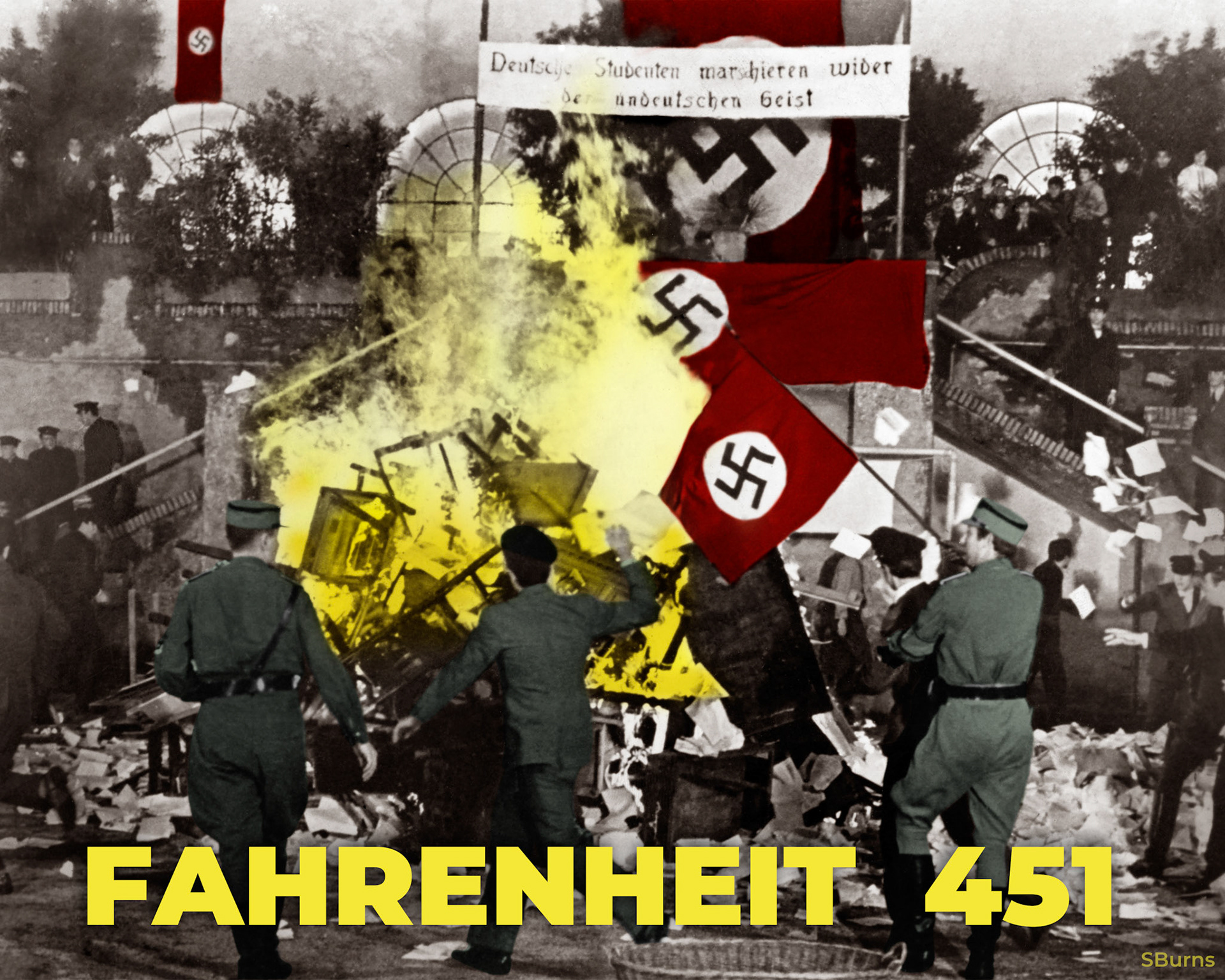

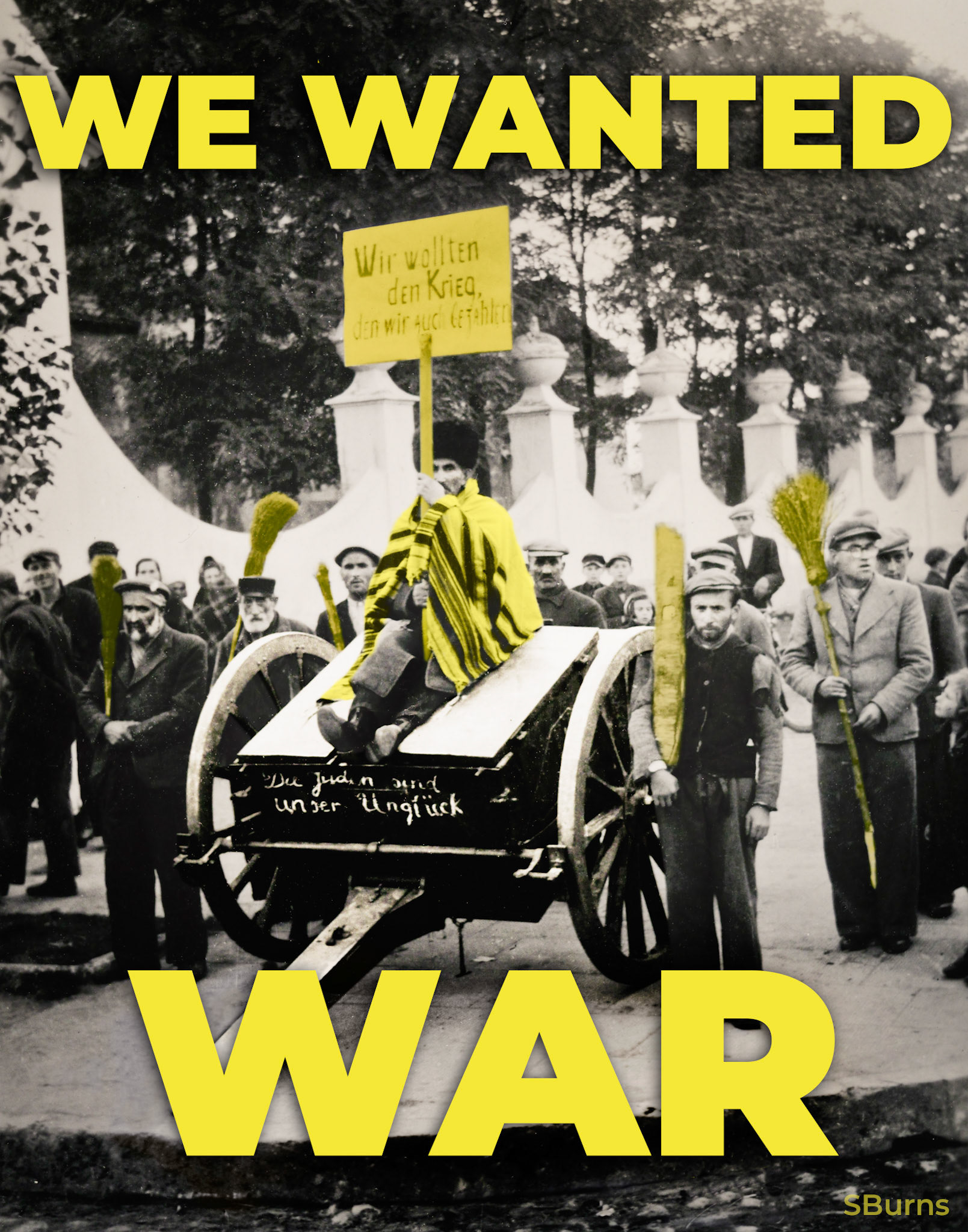
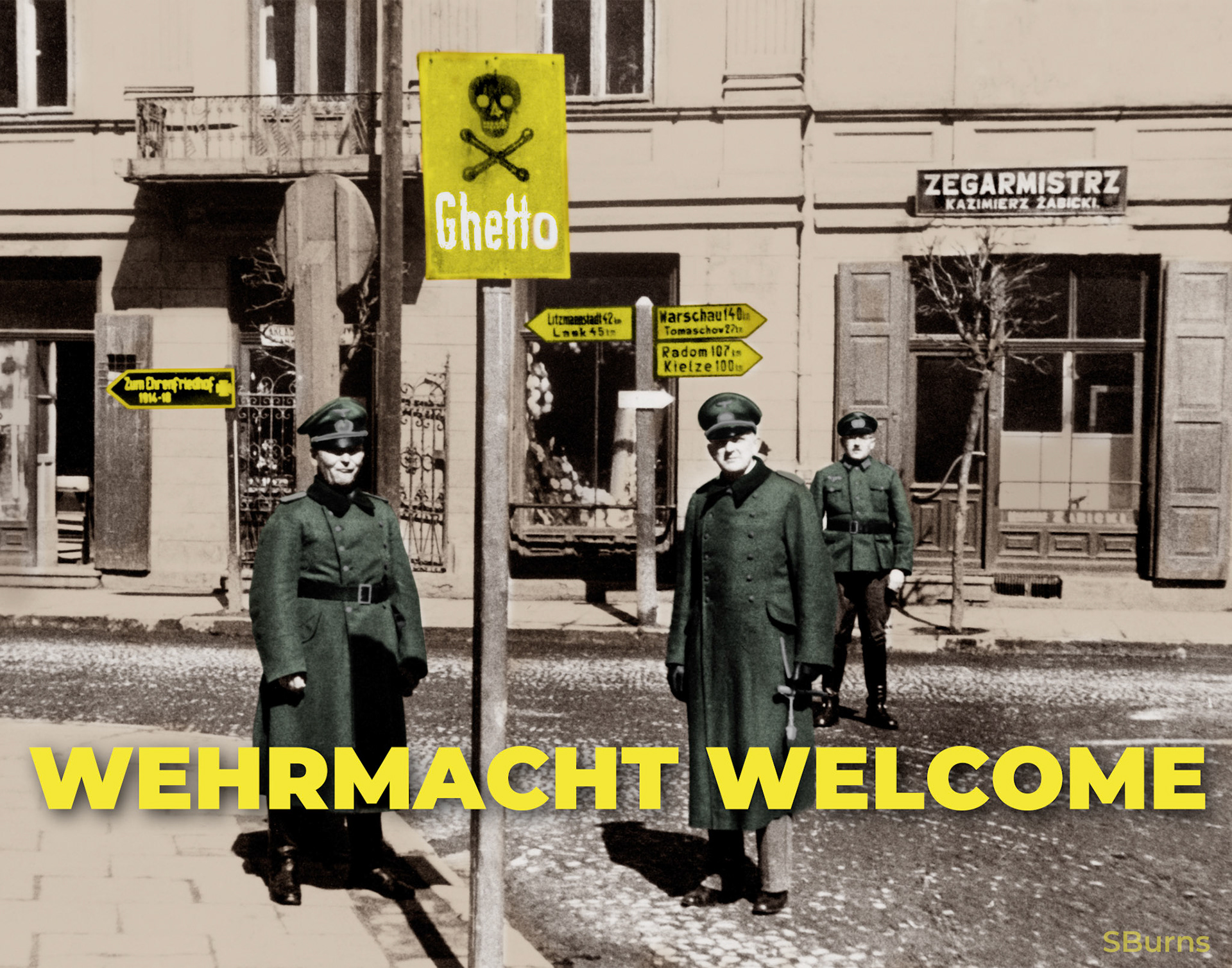
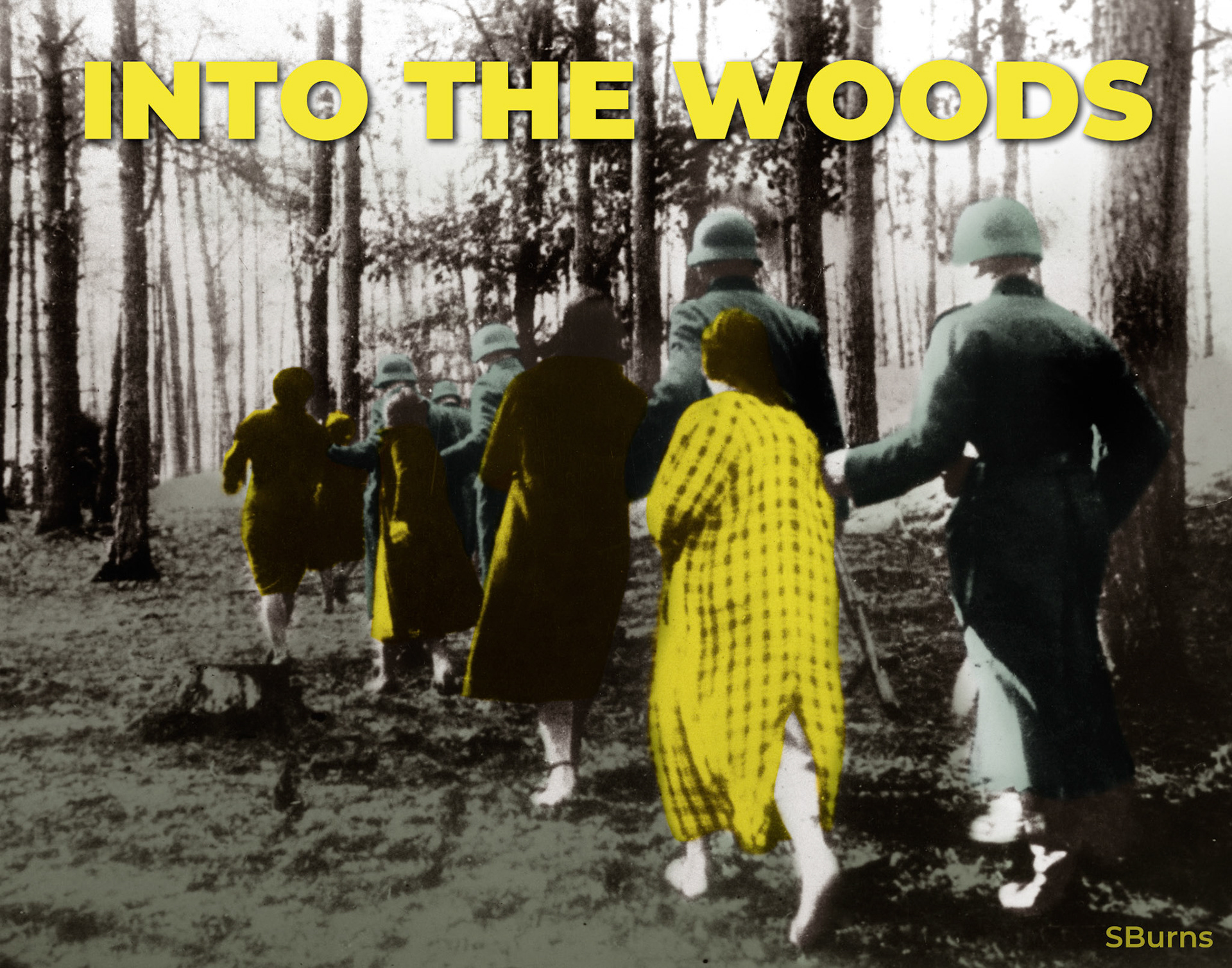
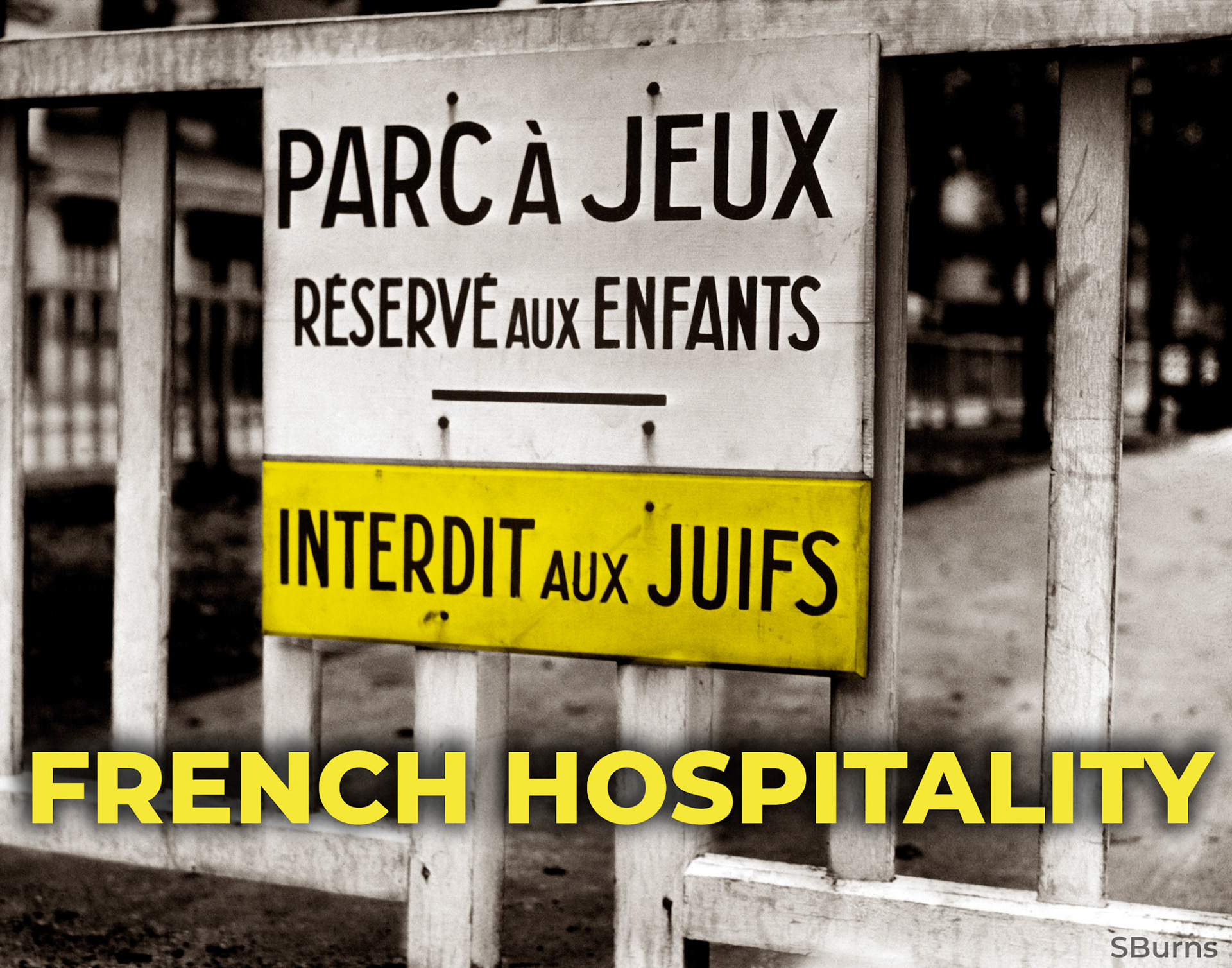
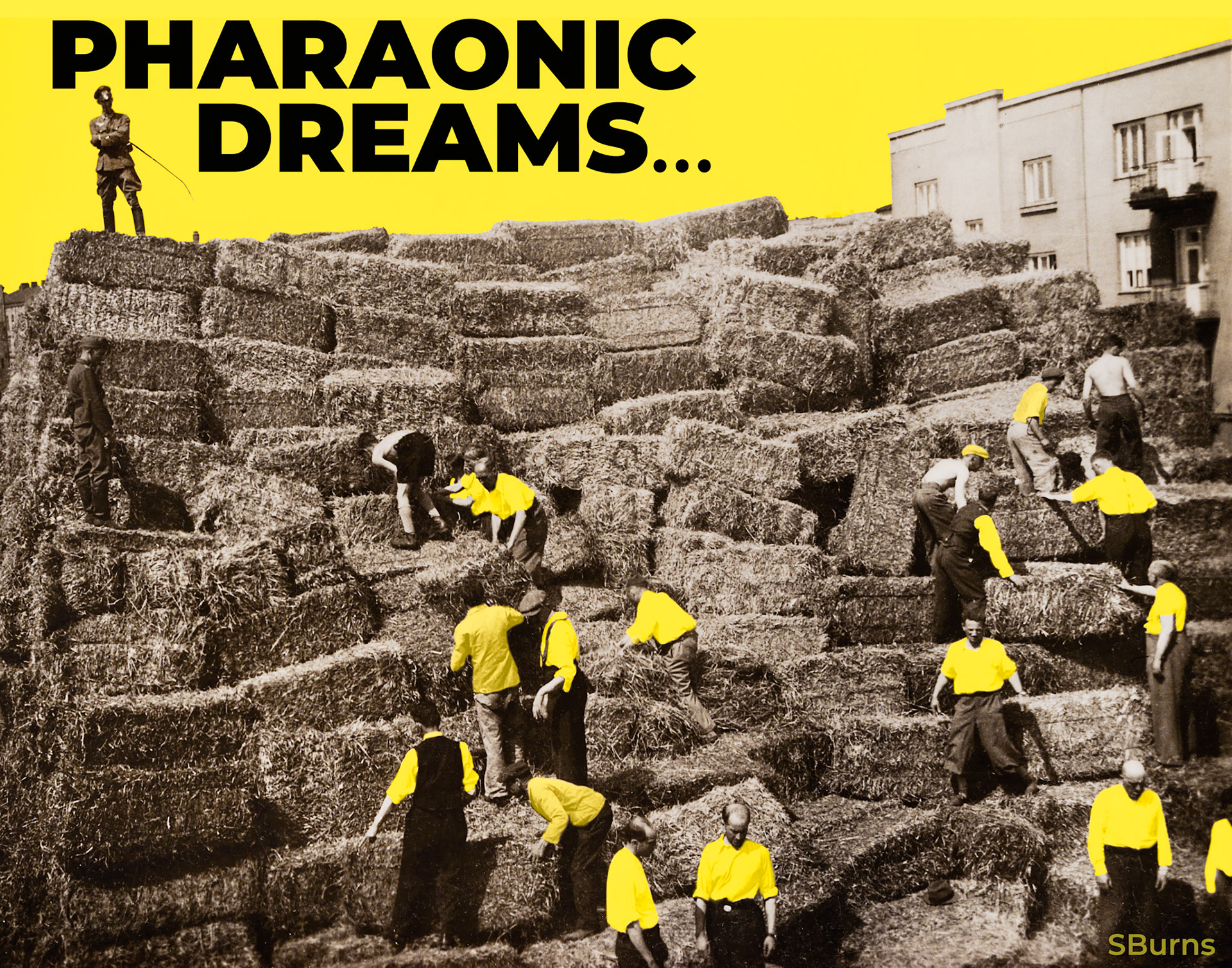
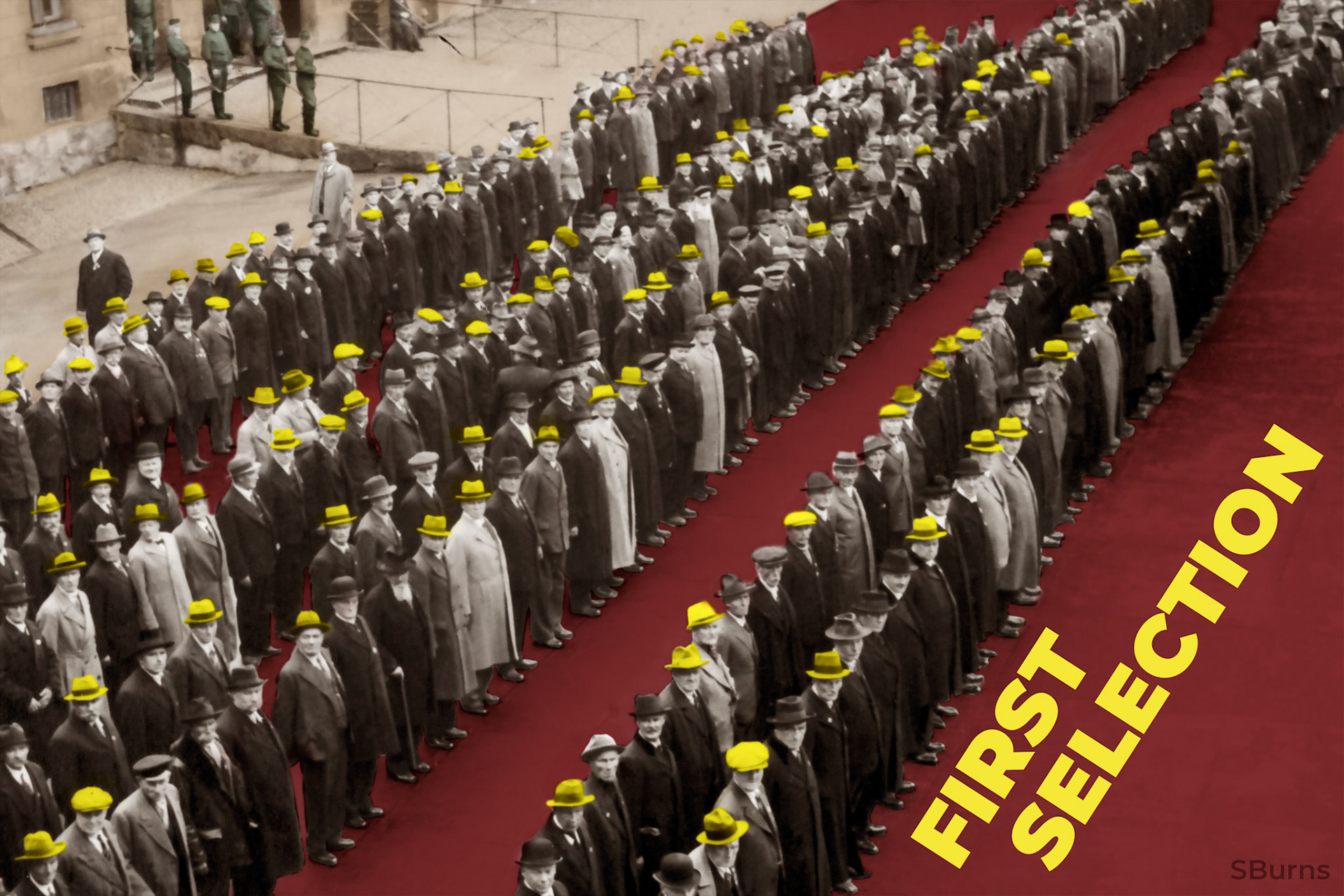
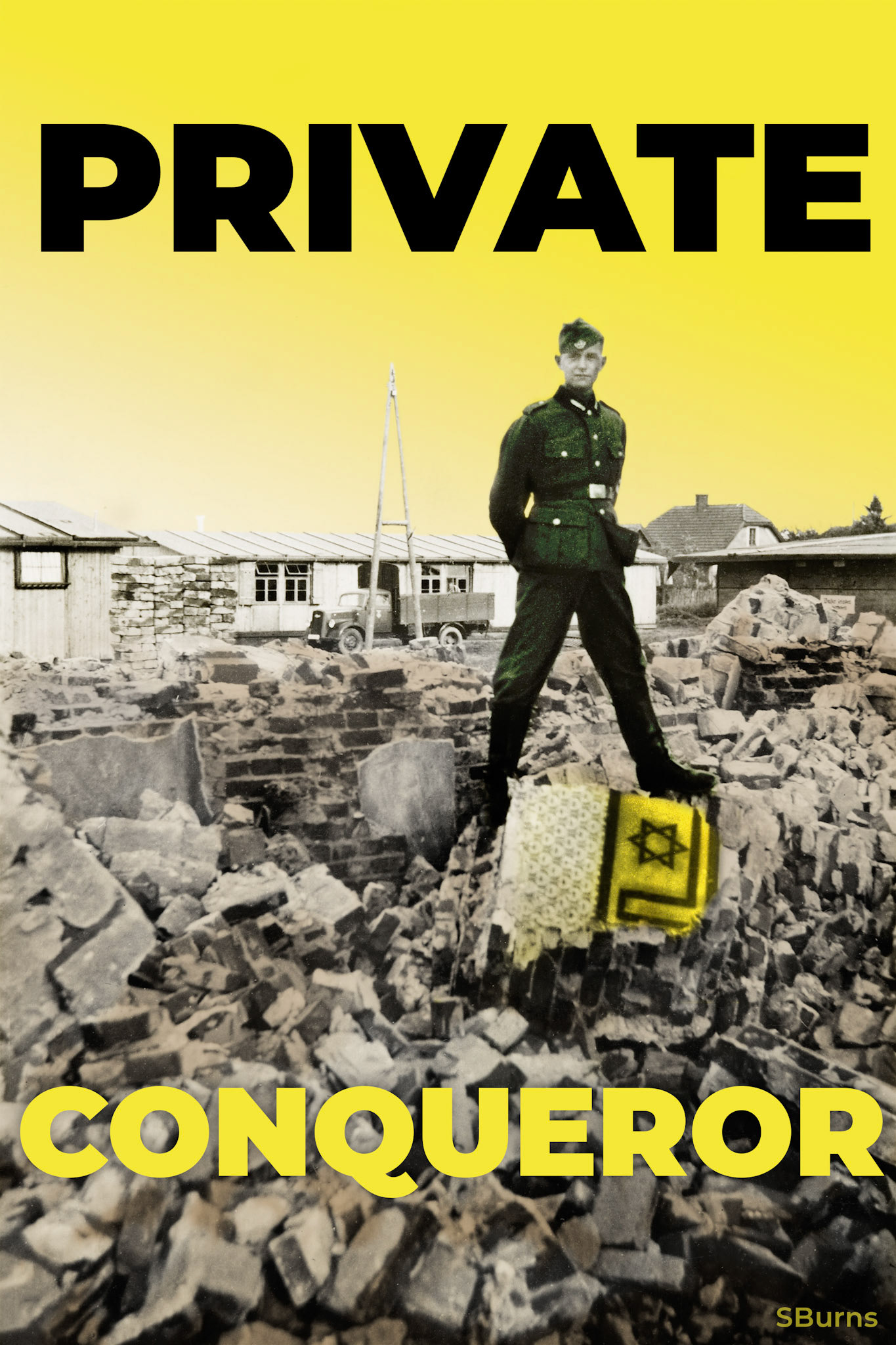
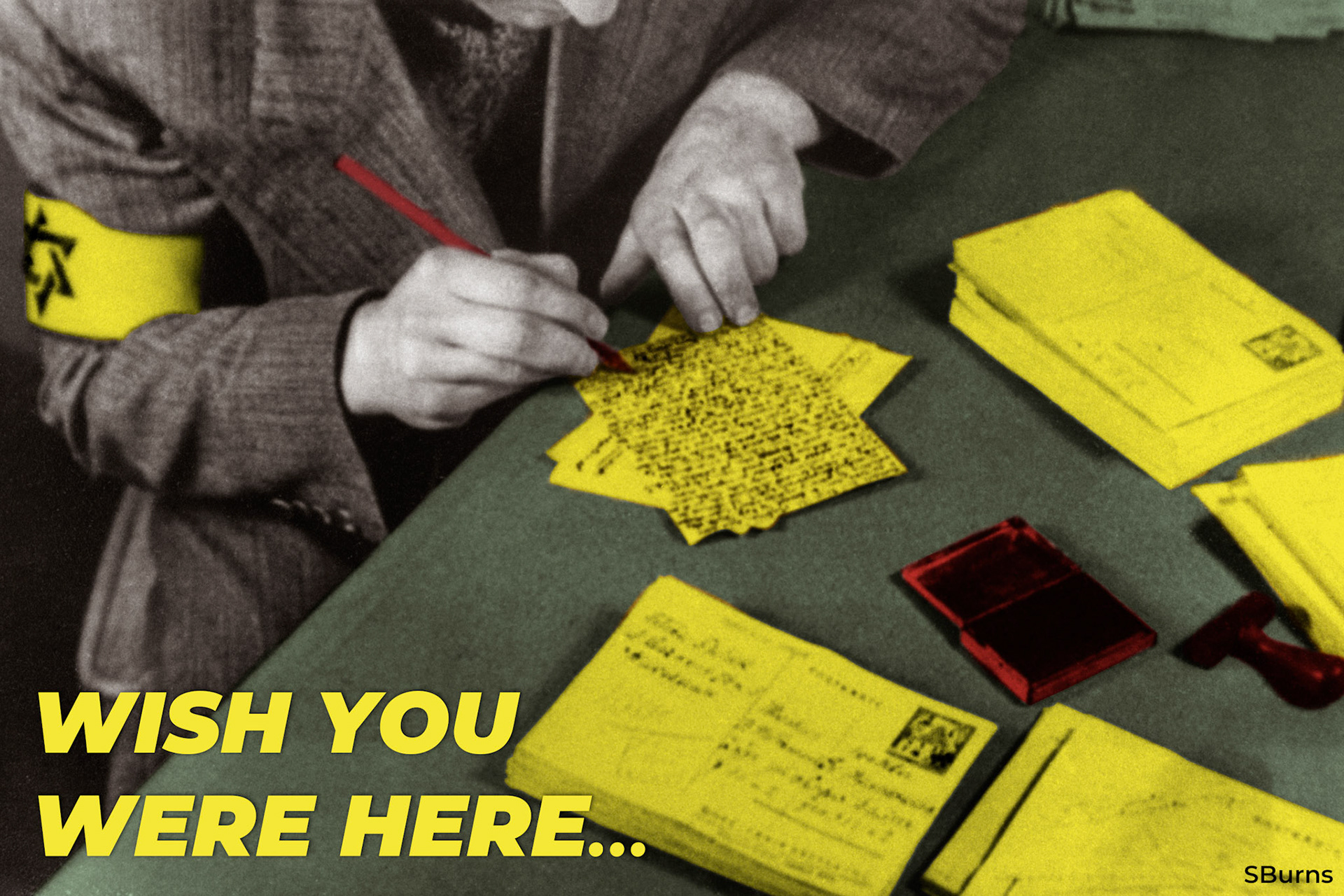
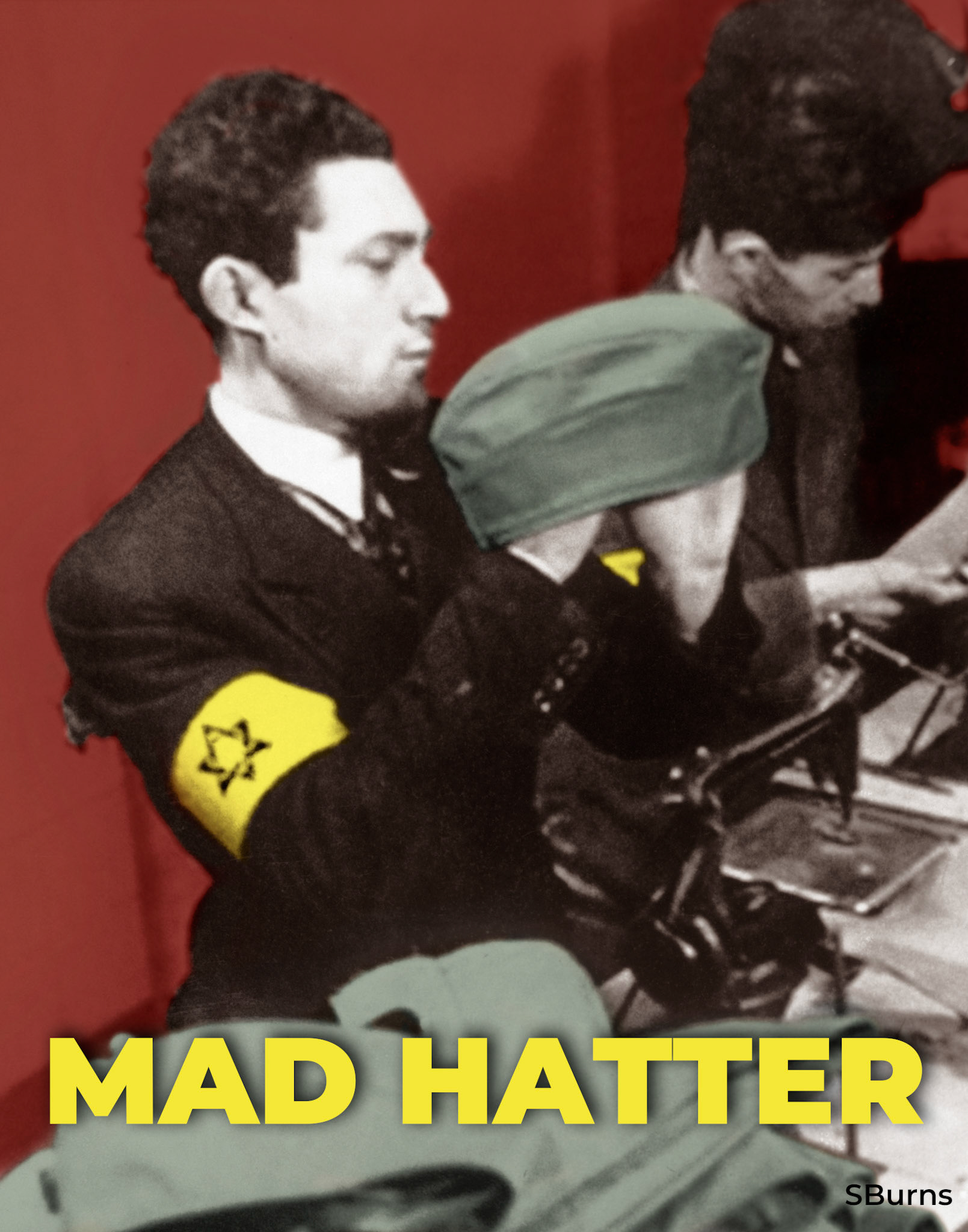
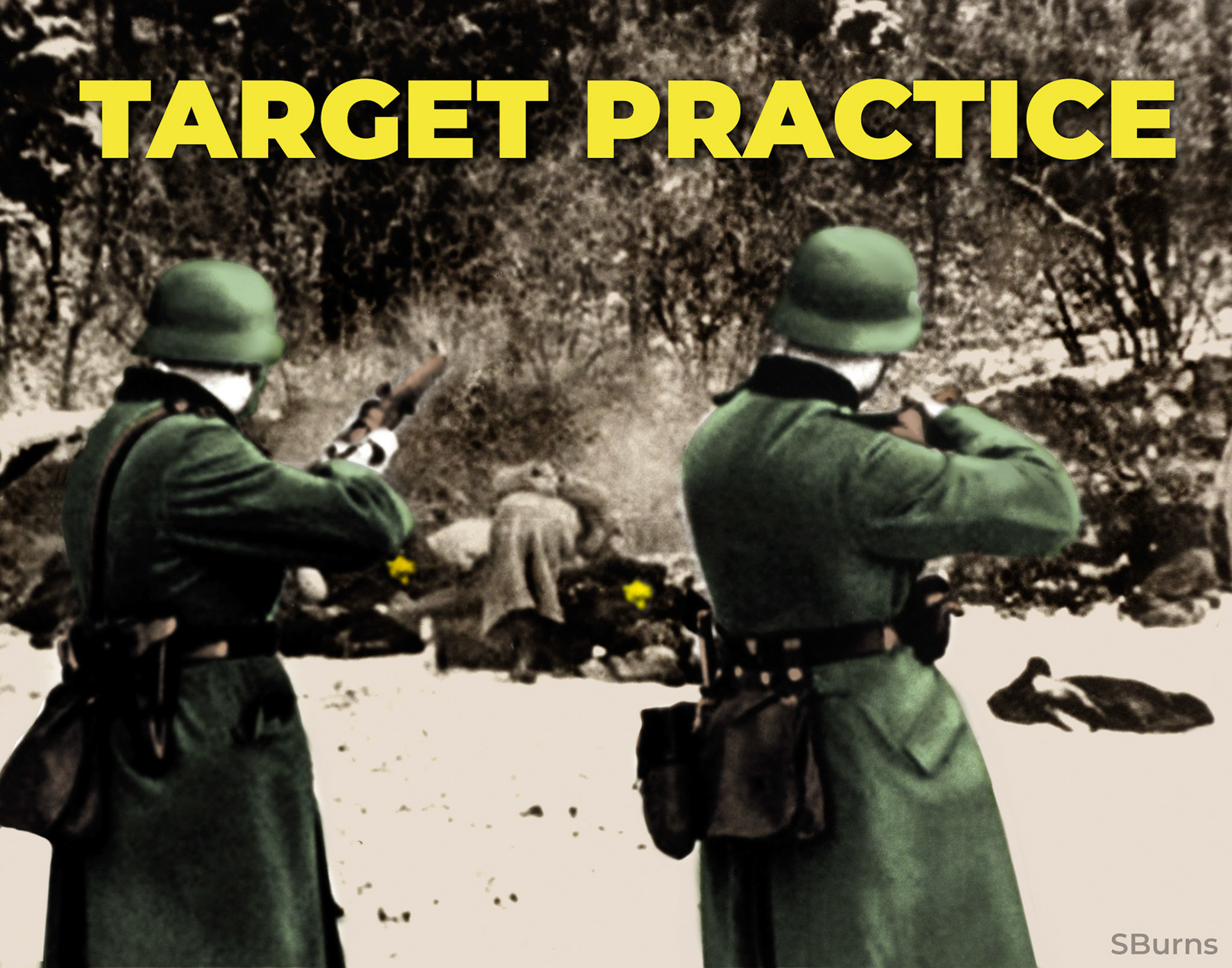


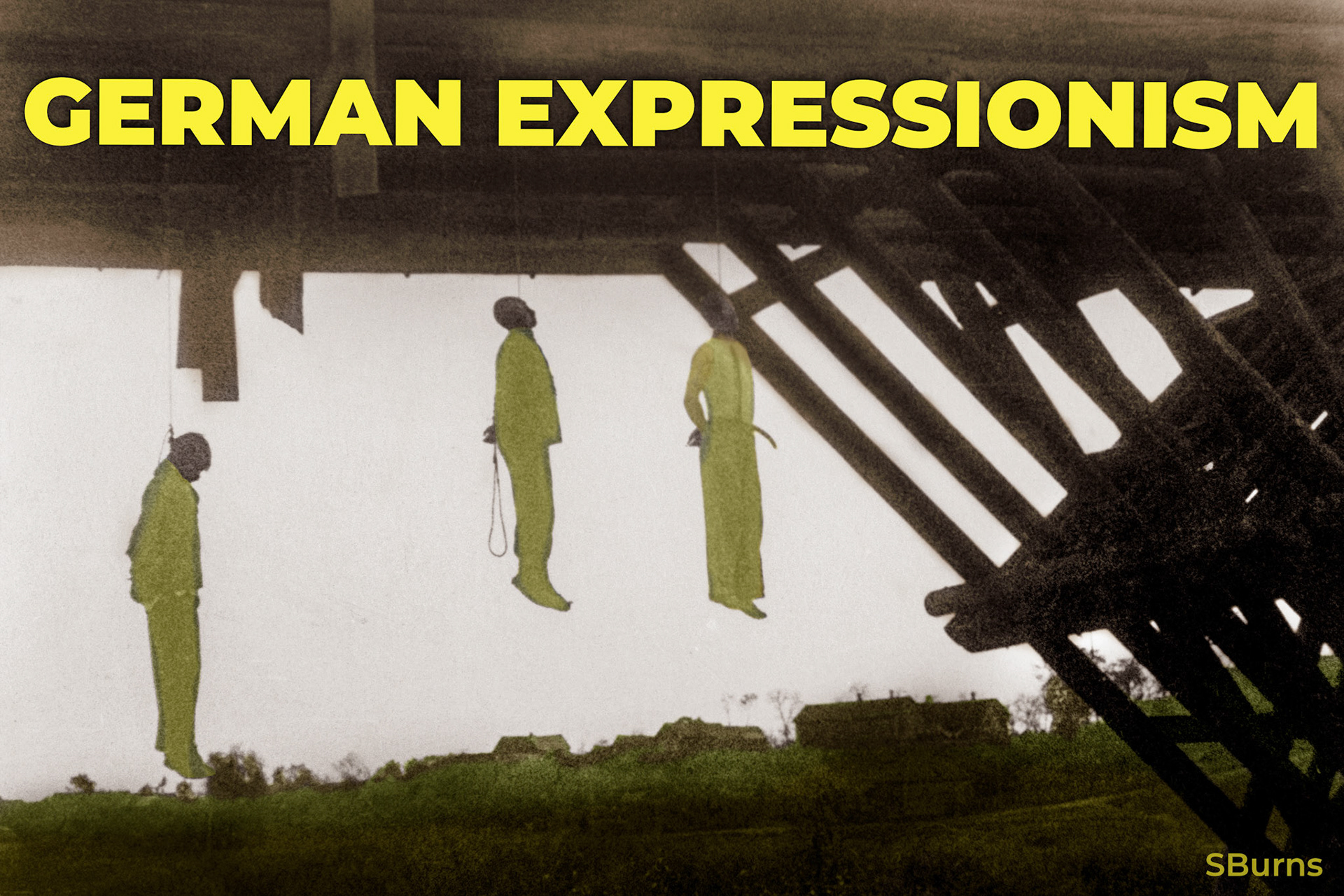

FAHRENHEIT 451 2012/1933
Books burn at 451 degrees Fahrenheit. One of Adolf Hitler’s first targets, when he seized power in Germany in March 1933, were books deemed subversive to Nazi ideology. Book burnings were a campaign conducted by the German Student Union (Deutsche Studentenschaft, DSt) to ceremonially burn books in public in Germany and Austria. All works whose subversive ideas conflicted with Nazi ideals were targeted, including Jewish, communist, pacifist, socialist, anarchist, and liberal authors. On the night of May 10, 1933, students in 34 university towns across Germany marched by torchlight in nighttime parades, singing chants and throwing books into huge bonfires. On that night, more than 25,000 books are burned.
FREE AT LAST 2010/1937
This 1937 photograph of a family proudly posing with a sign that reads “Farewell from Germany” is a rare surviving example of Jews photographing their success at emigration. The Nazis wanted the Jews to leave Germany but did not make the process easy. They used the legal system to rob Jews of their financial assets. The percentage of confiscated funds increased from 20% in 1934 to 96% by 1939. Emigrating Jews were required to surrender their possessions and leave with limited funds. By 1937, when this photograph was taken, most of Germany’s Jews had been forced out of the country.
For almost 1,500 years, Jews were part of German society and, by the early twentieth century, numbered about 550,000. Tens of thousands were respected and established business people, doctors, lawyers, and other professionals. In January 1933, Adolf Hitler, leader of the Nazi Party, was elected Chancellor of Germany, and everything changed. The ideology of the Nazi Party was antisemitic nationalism. Jews were labeled an inferior and dangerous race, defined by blood, not religion. In the Nazi’s crusade to save Western civilization, Jews had to be eliminated. Antisemitic laws were passed to curtail the rights of Jewish citizens. The first major law in their strategic vision was the Law for the Restoration of the Professional Civil Service (April 7, 1933), excluding Jews from civil service. Further laws barred Jews from practicing professions and trades. The Nazis continued to put their beliefs about race into law, and in September 1935, Hitler announced The Nuremberg Race Laws, by which only racially pure Germans could be citizens. Jews, defined as a separate race, could not be citizens and lived under 400 decrees and regulations that restricted all aspects of their public and private lives.
WE WANTED WAR 2010/1939
Nazis force Jews to parade through Warsaw with a cart. A Jewish man wrapped in a Talit (prayer shawl) and a Shtreiml (a fur hat worn by Hassidic Jews on the Sabbath) holds a sign reading, “We Wanted the War.” The inscription on the cart states, “The Jews are our Misfortune.” As a further sign of humiliation, some of the Jews walking alongside the cart are forced to carry brooms.
Germany attacked Poland on September 1, 1939, and on September 27, Warsaw fell into German hands. A few days later, Nazi officers rounded up Jews and forced them to parade through the city. Antisemitism was already embedded in Poland, and the Nazis further provoked the defeated Polish populace with processions of Jews. Attributing the War to the Jews was ridiculous, but clever Nazi propaganda resulted in pogroms, attacks against Jews by the Polish population.
The complete annihilation of the Jewish people was the objective of the Nazis. The Holocaust and the removal of Jewish culture and life from Europe was the most successful genocide of the twentieth century. In 1939 there were 17 million Jews in the world. The Nazis and their collaborators murdered 6 million, over one-third of the world’s population. In 2024, 85 years after the War started, Jews have not yet recovered their pre-Holocaust numbers. The world’s Jewish population is only about 15 million, of which Israel and the United States each count about 7 million. There are 2 million fewer Jewish people alive today than in 1939.
WEHRMACHT WELCOME 2017/1941
Wehrmacht soldiers stand at the entrance to a new Polish ghetto. To systematically and efficiently murder the Jews, one of the first actions was to gather them into one place, a ghetto. The creation of ghettos was a key step in the Nazi process of brutally separating, persecuting, and ultimately destroying Europe's Jews. The Germans established over 1,140 ghettos in occupied Eastern territories. The largest was in Warsaw, containing 400,000 people; Lodz numbered 160,000, and Krakow 18,000. Some ghettos existed for only a few days; some ghettos lasted for years. The intention of a ghetto was to starve, spread disease, and, at last resort, send survivors to extermination camps.
INTO THE WOODS 2012/1941
In June 1941, a released press photograph shows German soldiers escorting Polish Jewish women into the woods to be shot and buried in an unmarked grave. The systematic extermination of Jews in Europe was well-recognized by the Western Allies by the end of the year.
In the United States in 1943, Eleanor Roosevelt, Albert Einstein, politicians, and other notables published The Black Book of Polish Jewry. The book presented, in graphic documented detail from “unimpeachable sources,” the atrocities, extermination camps, mobile gas chambers, and execution squads murdering Jews across Europe. Despite aggressive lobbying by numerous activists, members of Congress, and public figures, antisemitism in America prevailed, and the United States did nothing about the extermination camps. The camps could have been destroyed by bombing.
FRENCH HOSPITALITY 2012/1940
A sign displayed on the small gate of a playground in the 9th Arrondissement of Paris on Rue de Rochechouart corner of Trudaine reads “Reserved for Children.” Below it is another sign stating “Forbidden to Jews.”
Germany attacked France on May 10, 1940. French forces were no match for the Nazi Blitzkrieg (overwhelming rapid air and mobile attack). Just 34 days after the first attack, the Nazis conquered Paris on June 14, 1940. On June 22, an armistice was declared, and a new government headquartered in Vichy, France, was organized. The terms of the armistice allowed the French to keep the French colonies and avoid total occupation by Germany. Only Northern and Western France were occupied by German troops. The Vichy French government was a collaborationist regime. By October 1940, Parisians were implementing Nazi Laws concerning Jewish life.
The French police force was kept intact and ultimately provided the Nazis with the registration and location of all French Jews. On June 7, 1942, Jews in Occupied France were required to wear a yellow star. Drancy Transit Camp was set up near Paris, and from there, Jews were sent to Auschwitz-Birkenau. French officials met German quotas for deportations, and by the time the Allies conquered France in August 1944, about 77,000 Jews had been murdered.
PHARAONIC DREAMS... 2010/1939
In a pointless exercise of humiliation and indignity, a Nazi officer in Tarnow, Poland, directs Jews to build him a pyramid out of bundles of hay in October of 1939. Thousand of years prior in Biblical Egypt, enslaved Jews labored to build the pyramids. The liberation of the Jews from slavery in Egypt, The Exodus, is a seminal event in the Jewish story and is commemorated as the Passover holiday each year.
The Nazi enslavement of Jews and other undesirables for forced labor expedited their annihilation and fueled the Nazi war machine. It is estimated the Germans abducted 12 million people from occupied countries. By the end of the war, a total of about 15 million had served as forced laborers during the war. Many workers died as a result of inadequate living conditions, extreme mistreatment, torture, and severe malnutrition.
FIRST SELECTION 2017/1941
After Tallinn fell to the Nazis in August 1941, the Jewish men are forced to line up for selection. Approximately 2,000 Jews lived in Estonia, the smallest of the Baltic countries; about half lived in Tallinn. Thousands had previously fled. With the help of Estonian collaborators, Einsatzgruppen A (the mobile killing squad for Northern Europe) murdered all the Estonian Jews by the end of 1941. At the Wannsee Conference in Berlin in January 1942, the Nazis proudly announced Estonia Judenfrei (free of Jews).
In city, ghetto, or concentration camp, selection, constant selection, was the plight of Jews living in Nazi-controlled Europe. The first concentration camp, Dachau, outside Munich, was established by the Nazis in March 1933. By the time the war ended, there were over 1,000 concentration camps and sub-camps. Selections for death were often made at the morning roll call. The process was heavily dependent on the labor needs of the camp. The Death’s Head Unit Totenkopfverbände of the SS Schutzstaffel ran the camps, which were places of violence, terror, and death. Roll call was performed in the early morning and at the end of the day. In the morning, the prisoners would be counted twice, and any discrepancies meant that they were recounted until the Nazis were satisfied. It could take hours. The prisoners would have to stand perfectly still until it was over, often in extreme weather. Prisoners that collapsed faced beating, torture, or execution. The bodies of those who had died since the previous roll call had to be brought out by the living to be counted. The combination of inadequate food and hard physical labor led to emaciation, starvation, and death.
At Auschwitz-Birkenau, selection began as people left the rail cars; men and women/children were separated into columns. Those deemed fit were chosen to work, and the others were immediately put to death in gas chambers. The four extermination camps, Chelmno, Belzec, Sobibor, and Treblinka, had no selection process; the Jews were brought directly to gas vans and killed.
PRIVATE CONQUEROR 2010/1941
A Nazi soldier, a private, the lowest rank in the army, is photographed standing on the capstone of a destroyed Jewish Synagogue on the Eastern Front. The Romans' destruction of the Second Temple in Jerusalem in 70 CE symbolized the end of Jewish life in the region, and the Nazi destruction of synagogues symbolized the end of Jewish life in modern Europe. Images such as these were often sent home to show the role a serviceman played in the triumph of Germany over the Jews.
The destruction of Jewish houses of worship began soon after the Nazis took power in 1933. The most notorious event was Kristallnacht (The Night of Broken Glass), named for the shattered glass that littered the streets. On the evening of November 9, 1938, Nazi leaders carefully orchestrated anti-Jewish violence throughout Germany and its recently incorporated territories. Over the next two days, rioters burned or damaged more than 1,000 synagogues. More than 7,500 Jewish businesses were ransacked. Some 30,000 Jewish men between the ages of 16 and 60 were arrested and sent to concentration camps. To add to the devastation, Nazi officials determined the ruined businesses would damage the German economy, so the Jewish community was fined one billion Reichsmarks. The Jews were also made responsible for the expense of cleaning up the damage and were barred from collecting insurance. Kristallnacht made it clear to German Jews that they were no longer wanted in Nazi-controlled territories.
WISH YOU WERE HERE... 2017/1942
A Jewish inmate is forced to write postcards noting that life is fine in their concentration camp. In some ghettos and concentration camps, the Nazis attempted to project a semblance of normalcy to the outside world. They allowed the International Red Cross to visit model camps, such as Theresienstadt. On visiting days, life at the camp appeared satisfactory. That is until the observers left. As part of the elaborate ruse demonstrating a safe and healthy environment, a writing campaign was overseen by Nazi censors.
MAD HATTER 2012/1942
A Jewish tailor is making a Nazi hat. German troops arrived in Lodz, Poland, on September 9, 1939, and in February 1940, established the Lodz Ghetto, which functioned as a giant factory supporting the German economy. All tradespeople were put to work in their specialized occupations.
Lodz, Poland’s second-largest city, was the center of the textile industry in prewar Poland. Under the German occupation, 164,000 Polish Jews were forced into a ghetto, a small area sealed, and surrounded by wooden fences and barbed wire, on April 30, 1940. The Lodz Ghetto became a major production center using forced Jewish labor. The Germans established factories in the ghetto, and in July 1942, there were 74 workshops. Nazi soldier uniforms were a major product. Jewish leaders in the ghetto made production as efficient as possible, hoping the work would keep them alive until the war ended. However, conditions were horrible, as most had no running water, electricity, or a sewage system. Food was limited, and starvation was a grim reality. In 1941 and 1942, almost 40,000 Jews were deported to the Lodz Ghetto: 20,000 from Germany, Austria, Bohemia, Moravia, and Luxembourg, and almost 20,000 from smaller provincial towns in Germany. About 5,000 Roma and Sinti were added to Lodz in a special area. In total, approximately 210,000 people were forced to live in the confinement of the Lodz Ghetto.
In January 1942, deportations to the extermination camp at Chelmno began. At this killing center, the SS used mobile gas vans. In September, 70,000 Jews from the Lodz Ghetto were killed; by the year’s end, over half the Jewish population was dead. The Lodz Ghetto then functioned primarily as a factory for almost a year and a half until 1944, when major deportations of large numbers of Roma and Jews resumed. They were shot or sent to Auschwitz-Birkenau. By August, only about 1,000 Jews were left, responsible for cleaning up and sorting through the possessions of the deported.
TARGET PRACTICE 2020/1941
German troops shooting Jews in Eastern Europe. As towns fell to the Nazis, Jews were routinely executed.
All through Eastern Europe, thousands of Jews were being shot every day as mobile killing units, the Einsatzgruppen, spread out across the continent. French Priest Patrick Desbois uncovered the truth describing in detail the shooting of one and a half million Jews from 1939 through 1943 in his 2008 text The Holocaust by Bullets. Mass executions were performed in broad daylight with precise efficiency. Town after town, collaborators were active participants and witnesses to the crimes. They were enlisted to serve the Nazis, identify the Jews, provide wagons, and dig mass graves. They were rewarded with Jewish possessions, homes, and businesses after the Nazis took their share. The Jews of the town were rounded up, transported, and stripped naked. They were forced to stand at the edge of a pit where they were shot in the head at close range and fell into the mass grave. The Nazis did not shoot children due to the cost of bullets; they brutally smashed their heads. The townspeople covered up the graves, and the Nazis moved on. The largest mass shooting occurred in Ukraine at Babyn Yar in Kyiv on September 29-30, 1941. In just two days, SS and police units shot 33,771 Jews. In June 1942, SS Commandant Heinrich Himmler ordered the thousands of mass graves of murdered Jews throughout Europe dug up and the bodies burned. The Nazis were hoping to cover up the killings; however, there were too many witnesses and too much evidence.
SERIAL EXECUTIONERS 2020/1941
A group of German police pose for a photo in Ukraine. The distinctive Polizeiadler insignia (wreathed police eagle) is on their helmets and uniforms. They are most likely security police.
When the War started, the German police were incorporated into the armed forces. Police groups ranged from ordinary order police Ordnungspolizei (ORPO) to the security police Sicherheitspolizei (SIPO). The notorious intelligence services, the Gestapo (Geheime Staatspolizei, secret state police) and SD (Sicherheitsdienst, security service), were both part of the SS (Schutzstaffel), the “racial elite” unit of Nazi Germany. Hitler assigned the SS with the responsibility of eliminating Jews.
The special action group Einsatzgruppen, mobile killing squads, were units comprised of 3,000 SIPO and SD personnel. They were split into four units, which were spread across the conquered territories. The Einsatzgruppen followed behind the army to exterminate the Jews. They were joined by ORPO, Wehrmacht soldiers, and local collaborators to fulfill the mission. These units were responsible for the “Holocaust by Bullets.” After the War, twenty-three battalions of ORPO, Germany’s ordinary men, were identified as perpetrators of mass murder and responsible for genocide and widespread crimes against humanity.
TOP GUN 2010/1941
A member of the Geheime Feldpolizei (GFP), the Nazi secret field police, is celebrating with a glass of wine. He is wearing a Star of David with the number 603 inscribed in the center, likely the number of Jews he shot or arrested that day. The Nazi high command ordered celebrations after each day of shooting executions.
The GFP was the secret military police of the German Army. They worked both in and out of uniform. Their mission was to eliminate security threats, which included murdering Jews. GFP Unit 721 in Ukraine killed 10,000 Jews from October 1941 through January 1942. The GFP also mounted operations to systematically burn down entire villages. Although the GFP was a distinct military organization, from its inception, it generally carried out the same duties as the Gestapo.
At the end of the war, Heinrich Himmler, head of the SS (Schutzstaffel, protection squads) and a mastermind in carrying out the Holocaust, posed as a member of the GFP. He used the alias Heinrich Hitzinger in an attempt to avoid capture. Unbeknownst to him, the GFP was on the Allied’s list of criminal organizations. He was captured by the Allies and, while in custody, committed suicide by cyanide.
GERMAN EXPRESSIONISM 2017/1942
Nazis often hung Jews, Commissars, partisans, and opponents. They routinely left their bodies hanging, sometimes for two weeks or more, as warnings and symbols of their authority.
German Expressionism was an early twentieth century art movement characterized by simplified, often twisted shapes utilizing vivid color. Distorted figures, buildings, and landscapes were common features. The artworks emphasized emotion.
FINAL SOLUTION 2010/1944
The well-marked identified graves of Nazi soldiers in Ukraine are each adorned with a helmet.
In January 1942, fifteen SS and Nazi party leaders held a secret meeting in Wannsee, a suburb of Berlin, to coordinate the implementation of the “Final Solution of the Jewish Question,” the official plan for the calculated and systematic mass murder of European Jews. Mobile killing squads were already slaughtering Jews, and the Chelmno extermination camp was in full operation, murdering thousands daily. The annihilation of the Jews by Germany and its collaborators required the coordination and cooperation of governmental agencies throughout Axis-controlled Europe. The Nazis formally revealed their plan to leaders who would help arrange for Jews to be transported to killing centers. “The Final Solution” was the euphemism referring to the eradication of the Jewish people.
The Allies’ “Final Solution” was the unconditional surrender of Germany. British Prime Minister Winston Churchill, United States President Franklin Roosevelt, and their advisors believed that the way to stop the Holocaust was to defeat the Germans. They chose not to bomb the rail lines or the extermination camps, and the war raged aggressively until May 7th, 1945, when Germany unconditionally surrendered.
After the war, the German War Graves Commission, Volksbund, was authorized to locate and identify the graves of German dead. Over four million Nazi soldiers lay buried, most in identified graves across Europe and North Africa. The search eventually led to the establishment of more than 400 cemeteries in Germany and nearly 500 cemeteries in 45 other countries. The collapse of the Soviet Union in 1991 granted access to Soviet-controlled areas. The Volksbund repaired more than 300 cemeteries and reburied more than 800,000 soldiers in 82 massive war cemeteries in the former USSR.
The murdered Jews are unidentified and buried in thousands of unmarked mass graves, pits, and ravines all across Eastern Europe. Modern technology and eyewitness testimony have resulted in locating many grave sites. Judaism teaches that human remains are sacred and must not be touched; exhumations are not carried out. Once found, ceremonies are held, and memorial monuments are placed. Numerous organizations continue to search for lost Jewish gravesites.
These artworks from Burns’ Without Guilt, Without Shame project will be on display at the CEPA Gallery in January 2024.
They have been published in German art magazines and exhibited at the National Arts Club and The Kupferberg Holocaust Center.
Through these artworks, Dr. Burns endeavors to address antisemitism and ensure remembrance of the Holocaust.
